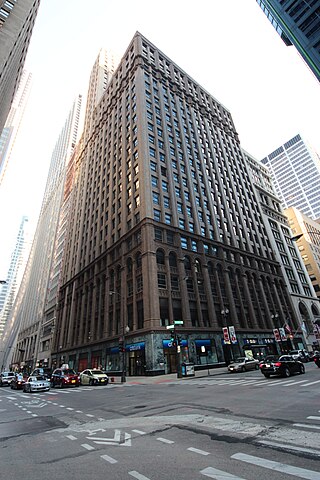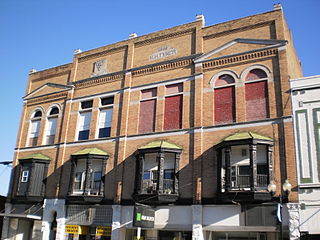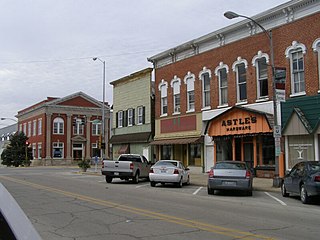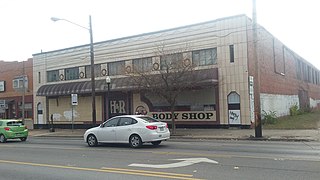
The Automobile Alley neighborhood and Automobile Alley Historic District in Oklahoma City is an upscale Urban area, located roughly along North Broadway Avenue in Downtown Oklahoma City. The district contains numerous low and mid-rise heritage buildings once home to the city's automobile dealerships, that today hosts many of the city's top bars and restaurants, retail shops, and urban residences alongside modern construction consisting mostly of residential housing and hotels. Automobile Alley is listed in the National Historic Register of neighborhoods.

The Sycamore Historic District is a meandering area encompassing 99 acres (400,000 m2) of the land in and around the downtown of the DeKalb County, Illinois county seat, Sycamore. The area includes historic buildings and a number of historical and Victorian homes. Some significant structures are among those located within the Historic District including the DeKalb County Courthouse and the Sycamore Public Library. The district has been listed on the National Register of Historic Places since May 2, 1978.

11 South LaSalle Street Building or Eleven South LaSalle Street Building is a Chicago Landmark building that is listed on the National Register of Historic Places and that is located at 11 South LaSalle Street in the Loop community area of Chicago, Illinois, United States. This address is located on the southeast corner of LaSalle and Madison Street in Cook County, Illinois, across the Madison Street from the One North LaSalle Building. The building sits on a site of a former Roanoke building that once served as a National Weather Service Weather Forecast official climate site and replaced Major Block 1 after the Great Chicago Fire. The current building has incorporated the frontage of other buildings east of the original site of Major Block 1.

The Galena Historic District is a historic district located in the city of Galena, Illinois, United States. The historic district encompasses 85 percent of the city of Galena and includes more than 800 properties. The downtown area consists of three successive tiers made up of Main, Bench and Prospect Streets. Within the boundaries of the district are such notable homes as the Ulysses S. Grant Home and the Elihu B. Washburne House. The Galena Historic District was added to the U.S. National Register of Historic Places in 1969.

The New Amsterdam Historic District is a historic district located in Detroit, Michigan. Buildings in this district are on or near three sequential east-west streets on the two blocks between Woodward Avenue and Second Avenue. It was listed on the National Register of Historic Places in 2001.

The Randolph Street Commercial Buildings Historic District is a historic district located in Downtown Detroit, Michigan, which includes six buildings along Randolph Street between Monroe and Macomb streets. The district was listed on the National Register of Historic Places in 1980. The collection of buildings are a rare surviving set of Detroit Victorian-era commercial structures. The Randolph Street Commercial Building Historic District joins the Broadway Avenue Historic District downtown.

An auto row or auto mall is a business cluster with multiple car dealerships in a single neighborhood or road. Auto rows are distinct from car supermarkets which are a single, large dealership.
Automobile Row was a commercial district in Midtown Omaha, Nebraska. Early reports place the location of the strip as extending Eighteenth to Twenty-first Street along Farnam, while contemporary accounts place it from 20th to roughly 26th Street. The row featured dealers, garages, and parts stores.

The Downtown Hinsdale Historic District is a set of seventy-three buildings and one park in Hinsdale, Illinois.

Stolp Island is a small island in the Fox River in Aurora, Illinois. In 1986 the island and its 41 buildings were added to the National Register of Historic Places as the Stolp Island Historic District. It covers 0.03 square miles (0.1 km2) of land area.

The Hartford City Courthouse Square Historic District is located in Hartford City, Indiana. Hartford City has a population of about 7,000 and is the county seat of Blackford County and the site of the county courthouse. The National Park Service of the United States Department of the Interior added the Hartford City Courthouse Square Historic District to the National Register of Historic Places on June 21, 2006 — meaning the buildings and objects that contribute to the continuity of the district are worthy of preservation because of their historical and architectural significance. The District has over 60 resources, including over 40 contributing buildings, over 10 non-contributing buildings, 1 contributing object, 8 non-contributing objects, and two other buildings that are listed separately in the National Register.

Hotel Row is both a National Register and locally listed historic district consisting of one block of early 20th-century commercial buildings, three to four stories high, located on Mitchell Street west of Forsyth Street in the South Downtown district of Atlanta. The buildings were originally hotels with ground level retail shops built to serve the needs of passengers from Terminal Station, opened in 1905. The buildings are the most intact row of early 20th-century commercial structures in Atlanta's original business district. The decline of Hotel Row began in the 1920s due to the increased availability of automobile transportation and the construction of the Spring Street viaduct, which made getting to hotels in the northern part of the city easier. In the 1950s and 1960s, the increase in air travel led ultimately to the demolition of Terminal Station in 1971.
The Downtown Plainfield Historic District is the historic downtown area of Plainfield, Illinois, United States. The four block district reflects popular architectural styles of the mid-19th through mid-20th century.

The Jennings Ford Automobile Dealership is a historic automobile dealership located at 431 South 4th Street in Springfield, Illinois. Ford dealer Frank Jennings built the dealership in 1919. The automobile became widespread in Springfield in the 1910s; Jennings Ford was one of several dealerships to open on South 4th Street, which was then the city's automobile row. The three-story building integrated every major function of an auto dealership at the time; it included a sales floor, a service center, a car wash, a storage garage, and a repainting facility. While Jennings Ford closed between 1927 and 1933, the building remained a car dealership through the 1950s. It is one of the few remaining dealership buildings in downtown Springfield and is the best-preserved of the survivors. Today, the building houses an operations center for Illinois National Bank.

The Downtown Momence Historic District is a national historic district which encompasses the commercial core of downtown Momence, Illinois. The district includes 49 contributing buildings, all but two of which are commercial buildings; the remaining two are residential. While the oldest building in the district dates to 1849, significant development in downtown Momence did not begin until the Chicago, Danville and Vincennes Railroad reached the city in 1871. Roughly one-third of the district's buildings, primarily retail stores, were built between 1871 and 1900. Most of the remaining buildings were built between 1900 and 1930; these were more diverse and included banks, entertainment and recreational facilities, and automobile-related businesses toward the end of the period. The architectural styles seen in the district are representative of American commercial architectural trends of the late 19th and early 20th centuries; the majority of the buildings have Italianate designs, though examples of Greek Revival, Classical Revival, and Romanesque Revival architecture can also be found in the district.

The Escanaba Central Historic District is a commercial historic district located along Ludington Street in Escanaba, Michigan, generally encompassing the 200-1800 blocks. The district was listed on the National Register of Historic Places in 2014.

The Cedar Rapids 2nd Avenue SE. Automobile Row Historic District is a nationally recognized historic district located in Cedar Rapids, Iowa, United States. It was listed on the National Register of Historic Places in 2015. At the time of its nomination it consisted of 24 resources, which included 17 contributing buildings, two contributing sites, four non-contributing buildings, and one non-contributing structure. This is a collection of commercial buildings that were built along the old Lincoln Highway between 1912 and 1953 to house automobile dealerships. They feature broad fronts with large display windows and open interiors. Auto repair shops were generally located at the rear of a dealership, but some were located in their own utilitarian buildings. Some of the corner lots were taken up by small gas stations. In later years, sales lots were placed adjacent to dealerships in order to display a larger number of cars. Other lots were occupied by used car lots. Prior to being converted into an automobile-centric commercial area, the district was a Victorian-era residential neighborhood. The multi-family dwelling at 309 8th St. SE remains as a reminder of that era, and it is one of the contributing properties.

The Davenport Motor Row and Industrial Historic District is a nationally recognized historic district located on the eastern edge of downtown Davenport, Iowa, United States. It was listed on the National Register of Historic Places in 2019. At the time of its nomination it consisted of 28 resources, which included 21 contributing buildings, one contributing site, one contributing structure, and five non-contributing buildings. The area was previously a part of the notorious Bucktown, a district of saloons, beer gardens, brothels, billiard parlors, gambling establishments, and theaters. Davenport licensed prostitution in 1893, gambling in 1904, and failed to enforce Iowa prohibition laws during this period. A crusade against vice by Davenport's Catholic bishop, Henry Cosgrove, and reforms by state leaders led to the district's transformation in the early 20th century into a light industrial area. The city's automobile industry settled here beginning in the 1910s. They stayed until the mid-20th century when Interstate 80 was completed on the north side of the city and they moved to the suburban areas. U.S. Route 32 and its successor U.S. Route 6 passed through the district on East Second Street from 1926 to 1937. The Government Bridge (1896), which for years was the city's only bridge across the Mississippi River, is immediately adjacent to the district.

The McClure-Nesbitt Motor Company is a historic automobile dealership in the South of Main neighborhood of Columbus, Ohio. It was listed on the Columbus Register of Historic Properties in 2017.



















